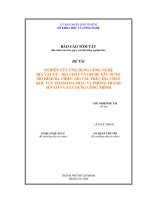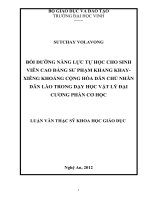VẬT lý địa CHẤN class3 earthquakes
Bạn đang xem bản rút gọn của tài liệu. Xem và tải ngay bản đầy đủ của tài liệu tại đây (7.44 MB, 40 trang )
This map was made with a combination of satellite predicted bathymetry and
topography from various sources. It gives us a chance to make some sweeping
tectonic statements. Can you identify many of the features?
What type of regional geophysical data might allow us to make better educated
guesses at what some of these features might be?
Seismology – What is a Wave
Seismology is primarily concerned with determining the structure of the earth – on
all scales.
To accomplish this it uses the ability of seismic waves to propagate through the
earth.
What is a wave?
Wavelength: The length
between two crests or
troughs
Amplitude: The maximum
height relative to the zero
position
Frequency: The number of
“wavelenghts” that pass a
point in one second
From: Mussett and Khan, Looking into the earth
It is important to note that although the waves
travels through the earth, the material itself does not
– in the same way as water.
Frequency
v = f *λ
Velocity = frequency x wavelength
Frequencies in seismology range from less than 10 to perhaps 100s of Hz (cycles
per second).
From Tarbuck and Lutgens, 2005
Ancient Seismographs
The Chinese made the first
seismographs over 2000 years ago.
This seismograph will tell the
observer the direction of the first
motion of the ground during an
earthquake
From Tarbuck and Lutgens, 2005
Earthquake
Nowadays, if an earthquake occurs, how do we detect it, and how do the waves
travel – in the next few slides I will attempt to answer these questions.
Detecting Seismic Waves
It is easy to visualize the motion of an ocean wave, and how we might measure its
wavelength, amplitude, and frequency, but how do we do this with the earth?
On the left are two basic seismometers.
When the ground moves the
pendulums moves either horizontally
(top) or vertically (bottom). The
movement is damped so that
subsequent motion of the earth is not
obscured by the pendulum oscillating.
On the right is a more conventional
seismometer. Motion of the magnet
through the coil generates a current in
the coil which is amplified and
recorded.
Three seismometers oriented vertically,
N-S and E-W are required to measure
the full ground motion.
Figures from: Mussett and Khan, Looking into the earth
Building A Seismometer
A basic seismometer is
actually very simple.
Shown here is a simple
seismometer that with the
addition of some
electronics (amplifier etc)
will happily record
earthquakes. Refer to
/>1.htm
for more details.
Snell’s Law
The earth is not a uniform sphere. Broadly speaking, it is made up of layers.
When wave fronts cross from one rock type into another with a higher velocity
they turn.
From Kearey et al., 2002
From Mussestt and Khan, 2000
Wavefront
The time between successive wavefronts remains unchanged, so the wavelength
must increase in the second rock in proportion to the increase in velocity.
v1 λ1 BB'
=
=
v2 λ2 AA'
BB'
sin
i
=
1
Trigonometry
AB'
tells us that:
AA'
sin i2 =
AB'
Rearranging
gives:
AB' =
BB'
AA'
=
sin i1 sin i2
Snell’s Law
As BB’ and AA’ are in proportion to the velocities v1 and v2, the equation can be
rearranged to
sin i1 sin i2
=
v1
v2
Snell’s Law
From Mussestt and Khan, 2000
sin 37 o sin i2
=
4
5
5
sin i2 = sin 37 o
4
So i2 = 48.8o
Answer the following question:
A ray traveling in a rock with a seismic velocity of 3 km/s encounters an interface
with a rock of 4 km/s at an angle of 45o. At what angle from the normal does it
leave the interface?
Snell’s Law – Multiple Horizons
From Mussestt and Khan, 2000
sin i1' sin i2'
=
v1
v2
sin i2' sin i3
=
v2
v3
As i’1 = i1, I’2 = i2, and so on
sin i1 sin i2 sin i3
=
=
= constant
v1
v2
v3
The ratio (sin i/v) thus remains unchanged
Snell’s Law – Curved Layers
However, in the real earth, the layers are curved, so it is not true that i2 = I’2, etc.
From Mussestt and Khan, 2000
The differences between the angles also depends
not on the velocities of the layers, but only on the
geometry of the triangle ABO. Snell’s law
determines how the angle of a ray changes on
crossing an interface, while geometry determines
the change of angle between interfaces. Now,
r1 sin i1 r2 sin i2
=
= constant = p
v1
v2
The parameter p is known as the ray parameter and
has the same value all along the path of any given
ray provided that v, i, and r are measured at the
same place.
Velocity-Depth Structure
Using an approximate velocity model, travel times can be calculated for the
distance to actual seismic receivers and compared with observed times. The
difference between the two is then minimized by adjusting the velocity-depth
curve. This is repeated for millions of earthquakes and hundreds of seismometers
all over the world. From this, a velocity depth model can be derived.
From Mussestt and Khan, 2000
Body Waves
There are two types of body wave (waves which travel through the earth).
P-waves – Travel through the
earth in a series of dilations and
compressions. Akin to sound
through air.
S-waves -- Shear wave, do not
travel through fluids, travel at
about half the speed of P-waves.
From Mussestt and Khan, 2000
Body Waves
S-Waves cannot travel through water. The passage of an S-wave depends on the
medium restoring its shape after initially being sheared. Water does not do this.
The S-wave velocity is always less than the P-wave velocity (vs = 0.55 vp).
From Mussestt and Khan, 2000
reflection :
sin i1P sin i1S
=
v1P
v1S
refraction :
sin i1P sin r2 S
=
v1P
v2 S
As the velocity of the S-wave is different to the P-wave, the angle of reflection of a
converted S-wave is not equal to the angle of incidence of the P-wave. Also, an Swave is refracted at a different angle to a P-wave.
Surface Waves
Water waves are an example of a surface wave.
They are slower than P- and S-waves and often have larger amplitudes.
From Mussestt and Khan, 2000
Particle motion is a vertical elipse.
It has both vertical and horizontal
motion.
Particle motion is horizontal
and transverse. It has only
horizontal motion
Surface wave amplitude decreases rapidly with depth, similarly to water waves.
Surface Waves
From Mussestt and Khan, 2000
Seismic Velocities
velocity of waves =
restoring force
appropriate mass
The velocity depends on two main things – the restoring force (analagous to the
strength of a spring), and the mass (analagous to the mass of the spring). As the
restoring force increases, the velocity increases. However, as the mass increases,
this will slow the spring, reducing the velocity. The mass in the case of a rock is its
density (mass per unit volume).
S-waves involve a change in shape – this requires a shear force. The size of the
force depends on the shear, or rigidity modulus, μ. A P-wave also involves a
change in size, so the compressibility modulus κ is also involved.
vs =
µ
ρ
Where ρ = denisty.
In a liquid, μ is
zero, so vs is
always zero.
From Mussestt and Khan, 2000
4
κ+ µ
3
vp =
ρ
Seismology of the Earth
As S-waves do not travel through liquid, they do not
travel through the outer core. As μ is reduced to
zero in a liquid, the P-wave velocity is reduced.
Mohorovicic discontuity: P-wave velocity jumps to
more than 7.6 km/s. This defines the crust mantle
boundary. The depth of this boundary varies from
5-6 km under the ocean floor to 70 km or more
below major mountains. The average is
approximately 40 km.
Low velocity zone: ~100 km depth. Not found
everywhere.
400 km discontinuity: Velocity increase abruptly –
olivine and pyroxene reorganize to more compact
forms.
600 km discontinuity: Additional phase/composition
change.
Ray Paths in the Earth
From Mussestt and Khan, 2000
A ray is named according to the parts of the earth
that it travels through – e.g a P-wave traveling
successively through mantle, core, and mantle again
is called PKP. A P-wave reflecting of the core is
named PcP, etc. These are referred to as phases.
There are no main P-wave arrivals in the interval 98 o
to 144o. This is the P-wave shadow zone. There are
no S-wave arrivals beyond 98o.
There are some weaker arrivals between 98o and
144o, because as well as ones reflected into it such
as PP, the inner core reflects some rays into it
(hence the discovery of the inner core).
Phases
Receiver gather for station 36 and shot line 8+23 (Gulf of Corinth, Greece). Data
are bandpass filtered between 3–8 Hz and reduced at 8 km/s. Horizontal axis is
shot-receiver offset. Stong, late phase between 10.6–13.0 s is Ps, interpreted as
a reflection from the subducting African slab. Weaker phase around 7 s is
probably PmP. Inset shows location of receiver (black dot) and shot line (black
line) in relation to other stations and shots.
Ray Paths in the Earth
From Mussestt and Khan, 2000
A theoretical travel time plot for an earthquake. Earthquakes that arrive at a distance
of greater than 18o are termed teleseismic. These are important as they not only
sample deep parts of the earth, but they come back to the surface at a steep angle,
spending as little time as possible in the highly variable crust.
2002 Denali Earthquake
From: />
Note: Animation only visible in
Earthquakes
From Mussestt and Khan, 2000
As both sides of the
fault move, strain
builds up across the
fault – fences may be
bent, etc. Once the
strain becomes more
than the fault can
support the strain is
released by elastic
rebound. Energy is
released as friction,
block movement, and
seismic waves.
Where was that Earthquake?
Unless we see rupture at the surface, which is rare, we do not know where the
earthquake occurred. Using first arrivals is limited – we can tell which station the
earthquake was closest to, but we do not know how long it took to get there.
From Mussestt and Khan, 2000
It is as if we are trying to tell how far away a storm is but we are not seeing the
lightning – we have only thunder to judge by.
Where was that Earthquake?
What if we use both the P- and S-wave (the thunder and the lightning)?
As S-waves travel more slowly than P-waves, the more distant the earthquake
from the receiver, the greater the lag of the S- after the P-arrival. There are
standard curves for this purpose:
In this case a P-S arrival time difference of 6.5
minutes equates to a epicentral angle of 46o. We
also know that the earthquake occurred about 8
minutes before the first P-arrival. If this procedure
is repeated for multiple earthquakes we can
triangulate the location
From Mussestt and Khan, 2000









